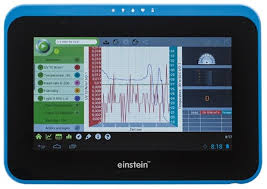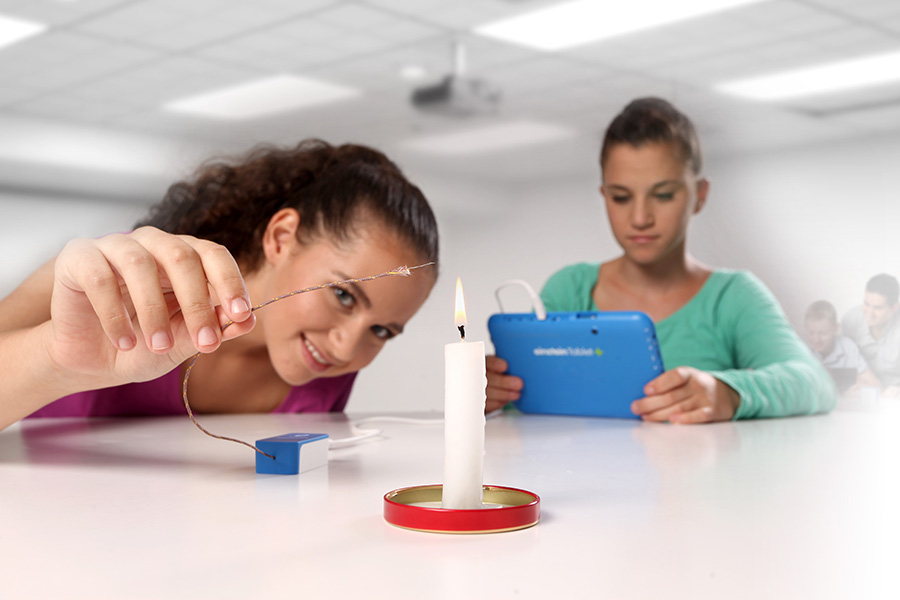einstein™Tablet
By Edwin P. Christmann
Posted on 2015-05-01
 Designed to provide an interactive laboratory experience to science students across a wide range of ability levels, the einstein Tablet+ is a mobile device produced by Fourier Education designed to provide an interactive laboratory experience to science students across a variety of ages and grade levels. Furnished with an android operating system, the einstein Tablet+ can access the internet and download and run android applications. For example, Fourier Education produces three applications for the einstein Tablet+, which are included with the device: 1) MiLAB, 2) Einstein World, and 3) TrackIt!.
Designed to provide an interactive laboratory experience to science students across a wide range of ability levels, the einstein Tablet+ is a mobile device produced by Fourier Education designed to provide an interactive laboratory experience to science students across a variety of ages and grade levels. Furnished with an android operating system, the einstein Tablet+ can access the internet and download and run android applications. For example, Fourier Education produces three applications for the einstein Tablet+, which are included with the device: 1) MiLAB, 2) Einstein World, and 3) TrackIt!.
Using the variety of sensors available with the device , the MiLAB application allows students to record, collect, and graph data. The device has built-in sensors that can be used to detect the following: 1) UV, 2) light, 3) humidity, 4) temperature, 5) accelerometer, and 6) microphone. The einstein Tablet+ also houses five ports that can be used with any of Fourier Education’s 65 external sensors. These sensors can be used for a variety of science applications. In addition to the sensor ports, the device is equipped with a headphone jack as well as USB, HDMI, and MicroSD ports.
 Students can collect data in real time by using the MiLAB application, which has several features that allow students to record their observations and to save data for later review. For example, students can record observations alongside their graph in the notes section or take a video of their experiment. In addition, students can save graphs and screenshots and “run back” recorded graphs to review the progress of their experiment over time from the beginning to the end.
Students can collect data in real time by using the MiLAB application, which has several features that allow students to record their observations and to save data for later review. For example, students can record observations alongside their graph in the notes section or take a video of their experiment. In addition, students can save graphs and screenshots and “run back” recorded graphs to review the progress of their experiment over time from the beginning to the end.
 Another nice feature of MiLAB is the ability to create a more detailed view of their graph using the zoom function. This application also allows users to record several replications of experiments and includes multiple measurements of several different variables from those experiments on the same graph. This feature also allows students to observe changes caused by manipulating an independent variable and observe the relationship between multiple variables.
Another nice feature of MiLAB is the ability to create a more detailed view of their graph using the zoom function. This application also allows users to record several replications of experiments and includes multiple measurements of several different variables from those experiments on the same graph. This feature also allows students to observe changes caused by manipulating an independent variable and observe the relationship between multiple variables.
Although most of the sensors worked very well, the heart rate monitor and the built in temperature and humidity sensors gave us some calibration issues. However, the external temperature probe appeared to be much more responsive and accurate. Overall, the MiLAB app does have some very nice features and in most cases worked well with the device.
[youtube]https://www.youtube.com/watch?v=Fv2aOeJjoEk[/youtube]
The einstein World application allows educators to download or create interactive lab presentations. The lab presentations combine videos, notes, and audio to provide students with background information and guide them through interactive lab activities. One advantage of the einstein World application is that students can collect and graph data during the activities without having to exit. Moreover, the einstein World application adds structure to labs and lends itself to spawning more autonomous learning.
A variety of lab activities are available for download from the online einstein World store [http://einsteinworld.com/product/einstein-tablet/], including experiments with sound, light, matter and energy, living systems, and health, among others. These activities are available in various levels are suitable for students in the elementary through high school levels. In addition, teachers can also create and customize their own presentations using the online Activity Maker.
The final application that comes with the einstein Tablet+ is the TrackIt! camera application. Using TrackIt!, students can take pictures and videos of their experiments. An excellent feature of this application is that it can be set up to take photos at preset intervals.
Overall, einstein Tablet and its accessories offer a great system data collection and analysis into science classrooms across a kaleidoscope of different scientific subjects and grade levels. While it may take some time to learn how to use all the available applications, once mastered, the einstein Tablet will provide your students with a valuable tool to do scientific inquiry.
Estimated cost:
$250 for the einstein™ Tablet+
Edwin P. Christmann is a professor and chairman of the secondary education department and graduate coordinator of the mathematics and science teaching program at Slippery Rock University in Slippery Rock, Pennsylvania, Katherine Wingard is a graduate student and a research assistant in the mathematics and science teaching program at Slippery Rock University in Slippery Rock, Pennsylvania, and Corissa Fretz is a graduate student and a research assistant in the mathematics and science teaching program at Slippery Rock University in Slippery Rock, Pennsylvania.
Disclaimer: The views expressed in this blog post are those of the author(s) and do not necessarily reflect the official position of the National Science Teaching Association (NSTA).


